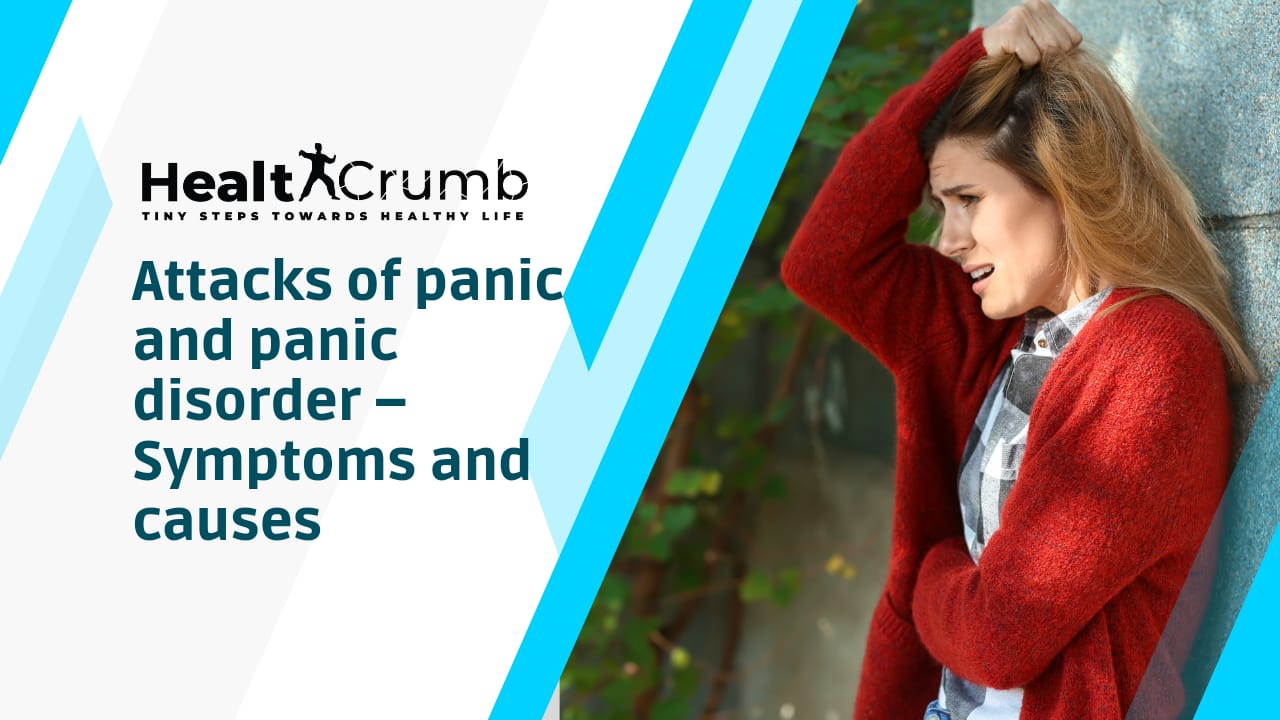Panic attacks can be so debilitating that many people don’t even realize they have them. In fact, a lot of people might not even know what panic disorder is if they haven’t experienced it firsthand. This article will go over the symptoms and causes of panic attacks, as well as some ways to treat them.
In this article, we will discuss some of the most common symptoms of panic attacks and panic disorder as well as explore some possible causes. Hopefully, by understanding what is happening during a panic attack and disorder, you will feel more equipped to handle one if it occurs or helps someone who is experiencing an attack.
What is Panic Disorder?
Panic disorder is a mental health condition that is characterized by recurrent, unexpected attacks of intense fear or anxiety. The attacks can be triggered by any number of events or situations, and can occur at any time. They can be so severe that they cause a person to feel like they’re about to go crazy or die.
People with this mental health condition may experience a range of symptoms. It can be severe and can interfere with a person’s everyday life. It’s important to get treatment if you have this condition, as it can be treated with medication and/or therapy.
The Symptoms of Panic Disorder
People with panic disorders experience recurrent and unexpected attacks of fear or anxiety that come on suddenly and without warning. Panic attacks can be accompanied by physical symptoms, such as a racing heart or shaking, as well as thoughts about dying or having a heart attack.
It is a mental illness that is characterized by recurrent and unexpected episodes of intense fear or anxiety. The cause is unknown, but factors that may contribute include genetics and biology, life experiences, and temperament. Panic disorder typically begins in early adulthood, often before the person has had any other mental health problems. It affects about 2 percent of Americans, more often women than men.
The hallmark symptom of this mental health condition is an intense fear or anxiety that comes on suddenly and without warning. Other common symptoms include rapid heartbeat, sweating, trembling, sensations of shortness of breath or impending doom, fear of dying or going crazy, and feeling like one’s heart might stop. Many people also experience cognitive symptoms – for example, difficulty concentrating or making decisions during an attack.
Many people with panic disorders seek help from their doctor because the attacks are disruptive to daily life. However, many people with the disorder do not get diagnosed because they do not experience all the symptoms listed above. To be diagnosed, someone must have at least two panic attacks that are not attributable to another medical condition or substance, and during which they experienced at least one of the following: a fear or sense of doom; chest pains; diaphoresis (sweating); lightheadedness; or fear of losing control.
Causes
There isn’t a one-size-fits-all answer to this question, as the causes of panic disorders are typically unique to each individual. However, there are some common factors that may contribute to the development of panic disorder. These include:
Anxiety disorders: People with anxiety disorders tend to experience more episodes of panic than people without anxiety disorders, and the type of anxiety disorder can also play a role in the development of panic disorder. For example, people with social anxiety disorder may experience panic attacks when they’re around other people, while people with generalized anxiety disorder may experience panic attacks during any type of situation.
Early life stressors: Childhood experiences such as neglect, abuse, or family dysfunction can lead to increased levels of anxiety in adulthood. This increased anxiety can trigger an attack of panic in someone who already has a tendency towards panicking.
There is no single cause of this mental health condition, but it is likely caused by a combination of genetic and environmental factors. Panic disorders often occurs in people who have a family history of anxiety or depression, as well as in people who have experienced traumatic events.
It can also be caused by a chemical imbalance in the brain, abuse disorder, chronic pain, or another medical condition. Panic attacks can be caused by a range of factors, but some of the most common are:
- Stressful life events
- A history of anxiety or panic disorders in family members or close friends
- Genetics
- Psychological factors, such as a traumatic experience or overthinking
Many people suffer from occasional bouts of anxiety, but for some people, these episodes become chronic and lead to panic disorder. Panic disorder is a mental disorder that involves recurrent panic attacks – brief periods of intense fear or anxiety that typically come on suddenly and without warning. Panic attacks can range in intensity from mild (anxiety that makes you feel shaky or jittery) to very severe (a full-blown panic attack that leaves you gasping for breath and trembling). Often, they occur when someone is confronted with a situation that they find threatening or uncomfortable. But panic attacks can also strike at any time, regardless of the circumstances.
The cause of panic disorder is still unknown, but there are several potential causes. Some of the most common symptoms include:
- Stressful life events: Panic disorder often occurs following a traumatic event – such as a death in the family or a serious injury
- A history of anxiety or panic disorders in family members or close friends: If a person has a genetic predisposition to anxiety or panic, they are more likely to develop the disorder.
- Psychological factors, such as a traumatic experience or overthinking: Panic disorder can be caused by a traumatic event or by overthinking certain situations.
- Medications: Many medications including antidepressants, beta blockers, and stimulants can cause panic attacks in some people.
Treatment for Panic Disorder
There is no one-size-fits-all approach to treating panic disorder, as the disorder depends on the individual’s symptoms and history. However, many of the treatments used to treat other anxiety disorders can be effective in treating panic disorder, including medication, therapy, self-care techniques, and relaxation exercises.
One important factor to keep in mind when treating panic disorder is that the disorder often has a comorbidity with other mental health conditions, such as anxiety or depression. If a person has coexisting mental health conditions, they should seek treatment from a specialist who can help them manage their condition and treat their mental health condition at the same time.
Medications typically used to treat the mental health condition includes antidepressants such as SSRIs (selective serotonin reuptake inhibitors) and SNRIs (serotonin noradrenaline reuptake inhibitors). These medications work by increasing serotonin or noradrenaline levels in the brain, which can reduce the severity of symptoms. Other medications used to treat panic disorder include beta-blockers and benzodiazepines, which work by reducing anxiety symptoms.
There is no one-size-fits-all answer to treating panic disorder, as the disorder can be caused by a variety of factors and require a variety of treatments. However, most experts agree that treatment involves addressing the underlying causes of the disorder and providing support to the individual.
Here are some tips for treating panic disorder:
1. Identify and address the root causes of the panic disorder: For example, if someone experiences recurrent episodes of panicking due to a fear of being alone or in confined spaces, he or she may need therapy to address those anxieties. Likewise, if someone’s panic attacks are triggered by life events such as job changes, relationship problems or major medical procedures, he or she may need therapy to learn how to deal with stressors in a healthy way.
2. Provide support and guidance to the individual during treatment. The goal for the person with panic disorder is to feel comfortable discussing his or her symptoms with healthcare professionals and receiving ongoing support and guidance. This may include group therapy sessions, self-help books and online resources.
3. Treat any co-occurring mental health disorders. Panic disorders often occurs along with other mental health conditions
Sometimes, medications are not effective or a person cannot tolerate them. In these cases, therapy can be an effective treatment option. Therapists may recommend medication management or cognitive behavioral therapy (CBT). CBT is a type of psychotherapy that helps people learn how to manage their symptoms and thoughts, which can help reduce anxiety levels. Self-care techniques can also be helpful in treating this mental health condition. These techniques include relaxation exercises, breathing exercises, and self-hypnosis.
Relaxation exercises involve practicing deep breathing and progressive muscle relaxation. Breathing exercises involve focusing on counting breaths and different types of yoga poses. Self-hypnosis involves using positive affirmations to relax the mind and reduce anxiety symptoms.
Conclusion
Attacks of panic and panic disorder can be incredibly debilitating, not just for the individual experiencing them, but also for those around them. It is important to note that panic disorder does not have a single cure, and it is often treated with a combination of treatments. People should consult their doctor to determine which treatment options are best for them.



